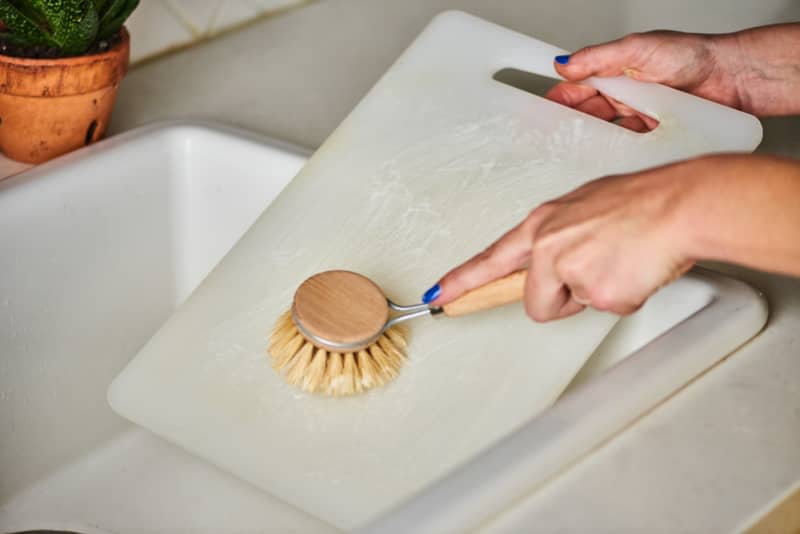Some People Are Ditching Their Plastic Cutting Boards Because of This New (Disturbing) Study

Plastic is everywhere. From the food we eat to the air we breathe, tiny particles of plastic — also known as “microplastics” — can be found in almost anything. Not only does plastic cause real havoc on our oceans and take centuries to decay, causing even more of an environmental crisis, but toxicologists have questioned whether consuming microplastics can negatively impact health. Especially if there are pieces of plastic you’re using on a regular basis, like say your handy-dandy plastic cutting board.
A recent study published by the journal, Ecotoxicology and Public Health evaluated the amount of microplastics found in a food between two different types of plastic cutting boards. Carrots were chopped on a cutting board made with polypropylene, and another with polyethylene. Scientists evaluated what the total exposure would be per person when using these types of plastic cutting boards. At the end of the study, they found these plastic cutting boards resulted in 1,114 microplastic particles (pieces of plastic less than 5 millimeters long) on the carrots each time the board was used. This means a plastic cutting board could generate 15 milligrams of microplastics per cut, and around 50 grams a year — the equivalent of 10 plastic credit cards.
With so many microplastics being exposed to our food, should consumers be worried? The Kitchn spoke with Alex LeBeau, PhD, MPH, CIH, a toxicologist and certified industrial hygienist on the impact on human health from using plastic cutting boards on a regular basis, and if there are healthier cutting board solutions we should consider.
The reality of consuming microplastics from our cookware
At first, the studies regarding microplastic consumption seem bleak. Evidence suggests that microplastics can be found in our blood, our lungs, and even our placenta, and can be potentially hazardous towards our physical health. A 2022 animal study in South Korea found microplastics could interfere with digestive, respiratory, endocrine, and even our reproductive systems.
And yet, while this research will make a plastic cutting board-user seem wary, it’s important to note that the science is still new and very limited. Dr. LeBeau points out that while the recent study evaluating cutting boards does prove the release of microplastic particles, it does not make any claims towards the negative effects these cutting boards can have toward human health. “The presence of the plastics under limited simulated conditions identifies them as a potential exposure source, but it is unclear if they are a human health hazard or pose any risk to consumers,” he says.
Plus, the studies that looks at microplastics potentially harming human health are all looking at correlation, without making any outright claims because the connection between the two is still harder to outright conclude. So the claim that microplastics can cause cancer? There’s actually no real scientific evidence to back it.
“These models have limitations when evaluating human health risks,” says Dr. LeBeau. “The ideal way to understand the impacts of ‘microplastics’ includes identifying the health effects in humans over a period of time or through standardized animal model studies.”
In order to actually determine long-term risks, Dr. Lebeau says a study would need to look at the impacts of microplastics on human health over a longer period of time. These studies also typically are conducted through standardized animal models, because asking a human to do so could border on being unethical.
“While we may have exposure to microplastics, there may be little biological interaction and the result is that they are actually not a risk to human health,” he concludes.
Should we replace our cutting boards?
With so much uncertainty around whether plastic cutting boards actually negatively affect human health, the question still stands: should we get rid of them just in case?
As of now, the answer is no. Dr. Lebeau says that we’re already consuming so many microplastics throughout our day (like in our food we eat from production, or even sometimes in our water even if it’s been filtered), that the microplastics from cutting boards won’t be making a huge difference.
Plus, Dr. Lebeau also brings up weighing the pros and cons of using other types of cutting boards. While using a wood cutting board may seem like a cleaner, safer option, these types of products are porous and may not be completely disinfected properly — a.k.a., increasing the risk of food-borne illness.
If you would like to avoid both altogether, the USDA recommends replacing your plastic and wood cutting boards with ones that are made from bamboo because they are denser and are less porous than other wood cutting boards, decreasing your risk. Just be sure to clean it as thoroughly as possible!
This post originally appeared on The Kitchn. See it there: People Are Ditching Their Plastic Cutting Boards Because of a New (Disturbing) Study

